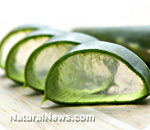The Healing Power of Aloe Vera
 |
Medical science embraces the healing power of aloe veraby: Brad Chase |
(NaturalNews) Aloe vera has been used as a healing agent for centuries. As far back as the days of ancient Egypt, aloe vera was prescribed as "the plant of immortality." Aloe vera is used to heal a variety of skin conditions, to heal wounds, and as a laxative when consumed internally. Even the FDA approves aloe vera as a food additive.
The National Center for Complementary and Alternative Medicine states that aloe vera is being used to treat diabetes, arthritis, epilepsy, and asthma. It is often used topically on burns and sunburns, but is also used to help treat psoriasis. The gel inside the aloe vera plant can be spread directly on the skin, and the leaves can be juiced.
Aloe vera lowers blood glucose and lipid levels and heals skin conditions
The British Journal of General Practice published a medical study in 1999 which reviewed all of the available research done on aloe vera to that time. The researchers found sound evidence that aloe vera could be useful in the treatment of diabetes patients by lowering blood glucose levels. Aloe vera could also help to reduce blood lipid (fat) levels, and possibly help create faster healing times in genital herpes and psoriasis.Dermatologists find a multitude of clinical uses for aloe vera
By 2008, dermatologists around the world were using aloe vera in numerous applications in the field of cosmetology. The Indian Journal of Dermatology noted over 75 different active components in the aloe vera plant. Aloe vera is full of vitamins and minerals, enzymes, mono and poly-saccharides, and laxative properties. It is antimicrobial, it provides pain relief, and provides fatty acids which are anti-inflammatory. In addition, aloe vera offers wound healing hormones and most of the human body's required and essential amino acids.There is scientific documentation that aloe vera is useful for the following health issues: dermatitis, psoriasis, herpes simplex virus-2, burns, type 2 diabetes, human immunodeficiency virus (HIV), and preventing cancer. There is also clinical proof that aloe vera works for ulcerative colitis, some cases of wound healing, radiation burns, acne, frostbite, and constipation.
Traditional literature suggests empirical evidence that aloe vera can also be used in the treatment of alopecia (hair loss and baldness), parasite infections, lupus, and arthritis.
Aloe vera tincture may be used as eye drops
An interesting new use for aloe vera is as eye drops for a variety of eye diseases. Pharmaceutical Biology suggests that an ethanol extract, or tincture, of aloe vera could be used to treat inflammations in the eyes and ailments of the cornea.Side effects of aloe vera
The side effects of aloe vera are few, and are mostly related to individuals who are allergic to the plant. In sensitive individuals, aloe vera may cause redness or stinging when applied to the skin. When consumed orally, aloe vera may possibly cause abdominal cramps, either diarrhea or increased constipation, or a red tint to urine color. The laxative effect of aloe vera may cause potassium levels to become low.Aloe vera is not recommended for pregnancy because of the remote possibility of triggering uterine contractions. It is also not recommended for breastfeeding mothers, because it may cause the baby's gastrointestinal system to become upset.
There is some concern about long-term oral use of aloe vera as a laxative. Rats fed aloe vera for two years, over half of their lifetimes, developed colon cancer in a toxicology study. While no such evidence has occurred clinically in humans, more study is needed to determine any possible risk to ingesting aloe vera over several decades.
Sources:
National Center for Complementary and Alternative Medicine.gov, "Aloe Vera"
http: //nccam.nih.gov/health/aloevera
Pubmed.gov, British Journal of General Practice. 1999 Oct; 49(447):823-8. "Aloe vera: a systematic review of its clinical effectiveness." Vogler BK, and Ernst E.
http://www.ncbi.nlm.nih.gov/pubmed/10885091
Pubmed.gov, Indian Journal of Dermatology. 2008; 53(4): 163-166. "Aloe Vera: A Short Review"
Amar Surjushe, Resham Vasani, and D G Saple
http://www.ncbi.nlm.nih.gov/pmc/articles/PMC2763764/
Pubmed.gov, Pharmaceutical Biology. 2012 Feb;50(2):147-54. "Aloe vera extract activity on human corneal cells." Wozniak A and Paduch R.
Pharm Biol. 2012 Feb;50(2):147-54.
http://www.ncbi.nlm.nih.gov/pubmed/22338121
Comments
Post a Comment